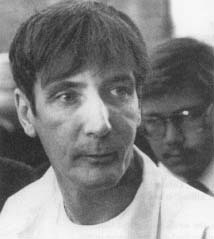Gary Mark Gilmore Trial: 1976
No Defense
In the face of such damning testimony, Gilmore's chief counsel, Michael Esplin, declared that the defense intended to offer no evidence, a decision that did not sit well with the defendant. Gilmore loudly protested that he be allowed to testify. Judge J. Robert Bullock told him, "I want you to fully understand that if you do that then you're subject to cross-examination by the State's attorney. Do you understand that?" Gilmore replied affirmatively.
At this point Gilmore's other attorney, Craig Snyder, stepped in with an explanation of why he and Esplin had offered no defense. Essentially both felt that there was no defense. Snyder's argument obviously impressed the mercurial Gilmore who abruptly said, "I'll withdraw my request. Just go ahead with it like it is."
"What?" gulped Judge Bullock, stunned by this turn of events.
Gilmore said it again. "I withdraw my request."
 Gary Mark Gilmore.
Gary Mark Gilmore.
All that was left was for both sides to make their closing arguments. At 10:13 A.M. on October 7, 1976, the jury retired to consider their verdict. Before mid-day they were back with a verdict of guilty. Later that day they unanimously recommended the death penalty. Because Utah had dual methods of capital punishment—hanging and firing squad—Gilmore was given a choice. "I prefer to be shot," he said.
When Gary Gilmore went to Death Row, nobody in America had been executed in over a decade, and nobody expected Gilmore to be the first—except Gilmore. He adamantly refused to appeal his conviction or sentence, dismissed both of his lawyers when they did, and insisted that he just wanted to be shot and be done with it. Anything, he said, was preferable to spending the rest of his life behind bars. Two failed suicide bids, on November 16 and December 16, 1977, only strengthened his resolve. Despite frantic legal wrangling by opponents of capital punishment, Gilmore got his wish.
On January 17, 1977, he was strapped to a chair in the Utah State Prison. Five marksmen took aim at the white circle pinned to Gilmore's shirt, then shot him through the heart.
—Colin Evans
Suggestions for Further Reading
McFarland, Samuel G. Journal Of Criminal Law And Criminology (Fall 1983): 1014-1032.
Mailer, Norman. The Executioners's Song. Boston: Little, Brown & Co., 1979.
White, Welsh S. University of Pittsburgh Law Review (Spring 1987): 853-857.
Additional topics
Law Library - American Law and Legal InformationNotable Trials and Court Cases - 1973 to 1980Gary Mark Gilmore Trial: 1976 - No Defense